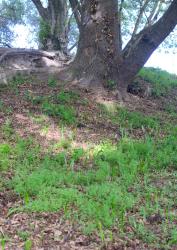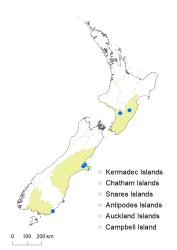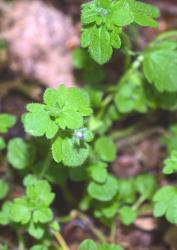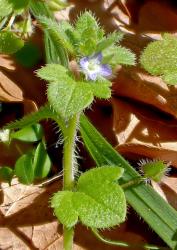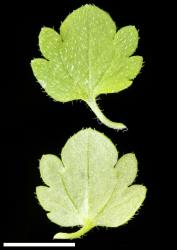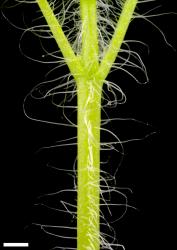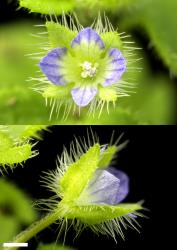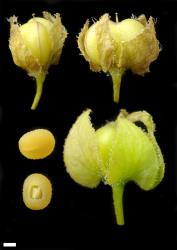Slender annual herb to 0.15 m tall. Stems trailing, decumbent, eglandular-pubescent; hairs bifarious. Leaf bud indistinct; leaves separating while small, opposite-decussate, erecto-patent to spreading; lamina thin, ovate to broadly ovate to more or less deltoid (lowest leaves elliptic), 8–18 mm long, 8–20 mm wide, dull green above, pale green to green beneath; veins 3–5 from base, depressed above, weakly prominent beneath; surfaces eglandular-hairy above and beneath; margin ciliate, bluntly lobed in 1–2 pairs; apex obtuse to rounded; base truncate to sub-cordate; petiole 2–10 mm long. Inflorescence a terminal raceme, sometimes resuming vegetative growth after flowering, 50–350 mm long; flowers distant, 5–20, all bisexual; bracts alternate, leaf-like; pedicels erect to sub-erect, 10–25 mm long, with mixed spreading and arcuate eglandular hairs in one row. Calyx lobes 4, acute 2.7–3.2 mm long at flowering, enlarging to 5 mm long at fruiting, sub-equal, eglandular-ciliate. Corolla 1.6–2.7 mm diameter; tube greenish-white, 0.5–0.6 mm long, < calyx, eglandular-hairy inside; lobes 4, pale blue with white base, sub-erect to erecto-patent, sub-equal, elliptic to broadly elliptic, 1.5–2.0 mm long, obtuse to rounded; nectar guides pale purple. Stamen filaments white, 0.5–0.6 mm long; anthers pale blue. Style glabrous, 0.4–0.6 mm long. Capsule angustiseptate, rounded, glabrous, 3.0–4.0 mm long, 3.0–4.5 mm at widest point. Seeds sub-orbicular, smooth with a small concave depression on funicle side, bluntly ribbed and convex on back, straw-yellow to pale brown, 2.0–2.5 mm long.
V. hederifolia plants are soft and sprawling, with a similar growth form to V. persica, but plants of V. persica differ in their serrate leaves with teeth in 3–8 pairs, pedicels hairy all around, larger flowers 8–12 mm diameter that open widely, calyx lobes with short, antrorse hairs along margins, longer style 1.5–3.0 mm, didymous capsules wider than long, with ciliate diverging lobes, and smaller seeds. V. hederifolia plants have a very distinctive calyx, where the lobes are narrowly triangular with cordate bases and long, fringing hairs along the margins. The corolla is small and pale and overtopped by the calyx.
North Island: Southern North Island (Takapau, Feilding).
South Island: Canterbury (Lincoln), Southland (Owaka).
Indigenous to Europe.
Lawns, flower beds, arable crops, under deciduous trees, railway yards. Recorded elevations range from 10 to 200 m.
Allan (1935, p. 8). Voucher CHR 1233, G. Reid, Owaka.
Flowers: August–March; fruits: September–March.
2n = 54 for European plants (Albach et al. 2008).
Veronica hederifolia is classified in V. subg. Cochlidiosperma (Albach et al. 2004; Albach & Meudt 2010).
V. hederifolia is part of a species complex in Europe. Sykes (in Webb et al. 1988) compared New Zealand plants to both V. hederifolia and V. sublobata (as V. hederifolia subsp. lucorum). However, they are considered a good match to V. hederifolia s. str. (D.C. Albach, pers. comm., 2020).



